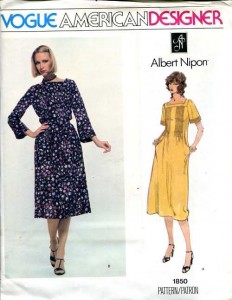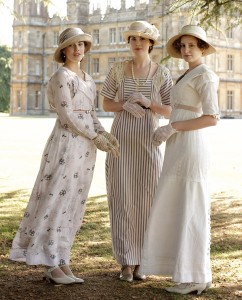Now, there are plenty of women who sew who are mining vintage pattern sites such as Vintage Pattern Lending Library, Folkwear, and Patterns of the Past to find patterns in styles that match what you see in the photo above. There are a lot of sewers who make costumes of all sorts, simply for the challenge (I mean now really, how much call is there for full-on Elizabethan doublets these days? Ditto for clothing of the 1860s, Victorian England and so on?).
Your Aunt Toby, however, is not a costume person (this said by the woman who just finished making a pattern, line for line, from 1930…twice). The intellectual exercise of building something like this from the inside out, to be worn once or twice, doesn’t hold a whole lot of attraction for me. I’m in awe of people who do it but I want to be able to wear my things multiple times so I invest my sewing time elsewhere. Which brings me to the topic (don’t you love my digressions..I could go on for days), which is this: What is it about this particular era which we find attractive. What makes people sigh over these clothes and make them want to recreate them. Or create something that feels like them?
Let’s look at Lady Mary in the center of the above photo. What is it about that dress that attracts? Taking away the length, which is period specific?
1. Square neck
2. Lace collar
3. Striped fabric
4. Little sleeves
5. Pieced bodice and skirt
What I really liked about that dress was the square neck. This is a neckline that is not seen much these days in women’s dresses and blouses but at this period, was very very popular. Another feature of the clothing (though not of this particular dress), particularly blouses of this period, were pin tucks (seemingly everywhere – skirt, bodice, and sleeves). Lady Mary wears a lovely blouse with kimono sleeves with pin tucks, a collar AND lace insertions, a veritable buffet of Edwardian style. So, how to get the look without the costume-ness?
 Enter, stage left: Albert Nipon. Nipon was an American designer and manufacturer of women’s dresses in the 1970s and 1980s (he ended up in prison for tax evasion in 1984) and had a licensing agreement with Vogue Patterns in the 1970s. Many of his designs for Vogue during this period feature pin tucks. This particular pattern, number 1850, features pin tucks AND a square neckline (Ding! we have a winner!). Nipon’s dresses were always considered extremely feminine in design and he many times used design details such as collars, scallops and so on. His dresses were very popular and his designs paved the way for the excesses of the late 1980s and early 1990s in terms of almost explosive puffed sleeves (think Princess Diana), pleated everything, huge lacy collars and the almost little girl-like design in dresses of that period.
Enter, stage left: Albert Nipon. Nipon was an American designer and manufacturer of women’s dresses in the 1970s and 1980s (he ended up in prison for tax evasion in 1984) and had a licensing agreement with Vogue Patterns in the 1970s. Many of his designs for Vogue during this period feature pin tucks. This particular pattern, number 1850, features pin tucks AND a square neckline (Ding! we have a winner!). Nipon’s dresses were always considered extremely feminine in design and he many times used design details such as collars, scallops and so on. His dresses were very popular and his designs paved the way for the excesses of the late 1980s and early 1990s in terms of almost explosive puffed sleeves (think Princess Diana), pleated everything, huge lacy collars and the almost little girl-like design in dresses of that period.
Am I going to make this dress? Yes I am. Am I going to try to recreate this in some sort of period-correct fabric? mmmmmmm…no. I have a lovely lavender rayon crepe which I think will look very nice. If I wanted to do this Dowton Abbey style, I’d have to go for some sort of thin linen or even cotton muslin type fabric. Although rayon (technically referred to as ‘viscose’) in some form or other had been available commercially in the UK by Courtolds Fibers starting in 1905, it was considered cheap goods (it was, after all, referred to as ‘artificial silk’), not very durable or color-fast. It was not until the 1940s that processes improved the fabrics. So, this dress will be reminiscent of that period, a figurative homage, rather than a literal recreation.


Toby this subject has been on my mind lately as I’ve been reading vintage sewing blogs by young sewers (whose results are all over the map in terms of being great fashion) and also as I’e been planning a summer shirtwaist dress that looks 40’s retro but is in reality a new Simplicity pattern and will be in a print that really wouldn’t have been used for a dress in the 40’s (it’s Aloha shirt print.) One thing that fascinates me about the Edwardian period is that the comfortable look of those clothes is just an illusion because women were still wearing corsets. Putting aside the comfort illusion however I think the appeal of this era is that these styles look good on a woman of any age. It wasn’t until the 1920’s that fashion started to segment itself into “youth” and “mature” looks for adult women. On DA both mother and daughters wear the same styles; the dowager duchess does dress about 20 years behind the times but that’s her conscious choice and she could dress in Edwardian styles she just chooses not to, it’s not like today where it’s much more difficult to find clothes (and patterns) designed for a woman over the age of 40 because the industry is designing almost exclusively for a youth market.
To me, the Downton dresses are costumes, but the Nipon dress, merely dated. Vintage clothing stores here are full of these “lady” nice dresses from the 70s and 80s; they are worn ironically by young women. If a woman our age wears it, she looks like she pulled something from the archive section of her closet. Perhaps you will be able to wear it to different effect.
Duchesse – maybe…maybe not. Ironic is definitely not in my style vocabulary.:)